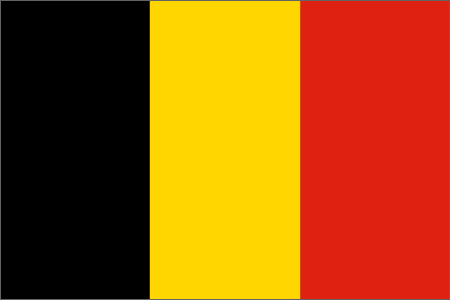
About Flag of Belgium
The black (hoist side), yellow, and red vertical stripes make up Belgium’s national flag.
Black makes up the hoist side stripe of Belgium’s national flag. The national coat of arms is represented by the colours of the flag, which are black, gold, and red. The colours of the shield are black, the lion is gold, and the claws and tongue of the lion are red.
After Belgium acquired independence from the Netherlands in 1830, the Belgian flag was formally adopted on January 23, 1831.
Facts about Belgium flag |
| Country | Belgium |
|---|---|
| Designed by | NA |
| Adopted | 23th January 1831 |
| Revision | 1950 |
| Design and Colors | A vertical tricolour of black, yellow, and red. Technically the national flag, but rarely seen. |
| Size Ratio | 13:15 (Proportion) |
| Official Name: | Kingdom of Belgium |
| Proportion: | 13:15 |
| Adopted on: | January 23, 1831 |
| Location: | Western Europe bordered by France, Germany, Luxembourg, and the Netherlands |
| Capital City: | Brussels |
| Major Cities: | Oostende, Brugge, Liege, Hasselt, Antwerp |
| Area: | 11,787 square miles |
| Population: | 11 million |
| Currency: | Euro (EUR) |
| Official Languages: | Dutch, French, German |
| National Anthem: | The Brabanconne |
| National symbol(s): | golden rampant lion |
| National colors: | red, black, yellow |
| National anthem: | |
| Name: | “La Brabanconne” (The Song of Brabant) |
| Lyrics/Music: | Louis-Alexandre DECHET[French] Victor CEULEMANS [Dutch]/Francois VAN CAMPENHOUT |
Design and Colors
The Belgium flag is a tricolor design consisting of three vertical stripes of equal width. The colors from left to right are black, yellow, and red. The flag’s width-to-length ratio is 13 to 15, creating a visually balanced and harmonious composition. Each color holds a special meaning that reflects the spirit of the Belgian nation.
Symbolism
The black stripe on the Belgium flag represents strength and power. It is a symbol of the historical region of Flanders, which encompasses Dutch-speaking areas of Belgium. The yellow stripe represents the historical region of Wallonia, mainly French-speaking areas, and signifies generosity and wealth. Lastly, the red stripe represents the historical region of Brussels, the bilingual capital region, and symbolizes bravery and valor.
The combination of these colors on the Belgium flag showcases the unity and diversity of the Belgian people, who come together as a nation despite their linguistic and regional differences. It is a powerful representation of the country’s commitment to harmonious coexistence.
Historical Significance
The Belgium flag has a rich historical background. It was first used in the 12th century during the Crusades and has evolved over time. The current design was officially adopted on January 23, 1831, when Belgium gained independence from the Netherlands. Since then, the flag has become an enduring symbol of Belgian national identity and has been proudly flown on various occasions.
National Pride and Identity
The Belgium flag holds immense importance to the Belgian people, evoking a sense of pride and unity. It is a symbol that represents the country’s values, cultural heritage, and achievements. The flag is prominently displayed during national holidays, sporting events, and international gatherings, where Belgians come together to celebrate their shared identity.

